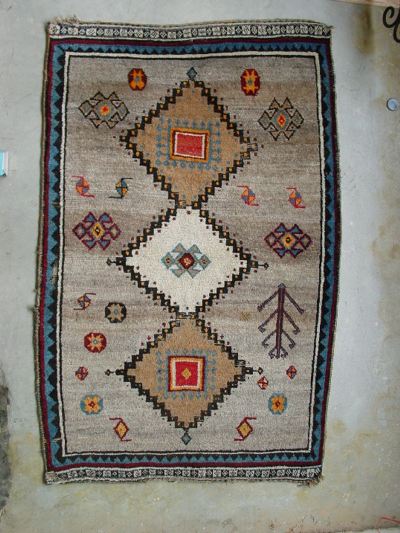
This size is smaller than the "typical" Luri rug. You can see another photo of this rug behind me in my photo in the portrait gallery. What are your thoughts as to the tribal origin?
Patrick Weiler
Gabbeh
Here is a photo of a gabbeh. It is 3 1/2 feet wide x 6 feet long.

This size is
smaller than the "typical" Luri rug. You can see another photo of this rug
behind me in my photo in the portrait gallery. What are your thoughts as to the
tribal origin?
Patrick Weiler
Hi Patrick,
Qasqaï at first sight.
All patterns are available in
Qasqaï kilims. Except for the fish bone maybe.
New "Gabeh" production can be
used as skating boards, if wheels are attached.
Nothing to do with the
original. In the 70'ties, the "Gabeh" production
was all brown and white.
All sizes available and pliable. Nothing to do with the original.
Think the
original had strong colours, high pile and was very pliable. More pliable
than
a kilim that was very sturdy and finely woven.
A Test:
It seems
the Gabeh is compressed at the upper half.
The triangle border at the top is
perfect.
Shouldn't it be at the bottom?
In short: Is it pile up or pile
down?
I know this is useless knowledge for most.
But I'm the scatty,
knowledgeable useless kind.
Going for a ride on my Gabeh-skateboard now.
Impress some skirts. Useless too.
Why do you call a pillow, a Dutch
wife?
Ah.....that's why my act is useless......
I'm living in the land
of pillows.....
Best regards,
Vincent
Right Side Up
Vincent,
The rug is shown right side up, the pile is pointing down.
The "fish bone" would normally be thought of as a "tree of life" design, but was
woven upside down, so it was either an unsuccessful latchook or it was purposely
woven with the "top" at the "bottom". It is not a motif I am familiar with from
other rugs.
This rug was probably made in the first quarter of the 20th
century. It is shaggy yet light-weight due to the 2-to-8 wefts: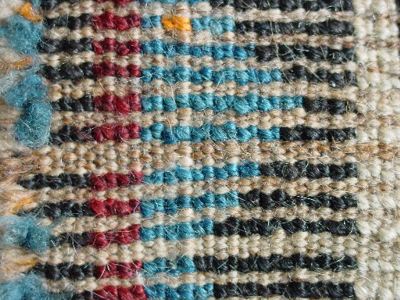
The one orange knot you
see is what has been described as a "counting" knot. On the right side of this
rug, at intervals of about every 6 inches, is one orange knot. There are no
corresponding knots on the left side: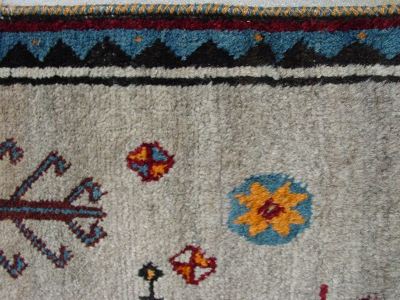
The spaciousness of the design
and the asymmetry might suggest a possibility that this could have been woven by
a Luri woman.
Patrick Weiler
Patrick, are there any other verified "Lur" gabbehs that you've run across? I don't remember seeing any. And I think when you're talking about gabbehs, "spaciousness" in the design doesn't really mean anything. I'd go with Qashqa'i on this one.
Let's not forget Bachtiar.
There was an article in a Hali. Can't remember
the number.
Think the dead fish can be seen in West Turkisch production.
Keyhole design, Bergama.
Best regards,
Vincent
Evidence?
A couple of interesting details from this gabbeh may be informative. The
light brown appears to be camel wool. It has a curve, or kink, to it unlike the
straight sheep wool used for the rest of the rug.
In this photo of one of
the camel medallions you can see the little diamond appendages to the square.
These diamonds are quite similar to those surrounding the medallions in one of
the Salon rugs. They have different colors inside them. The small squares and
crosses in the black border and around the medallion are of different
sizes.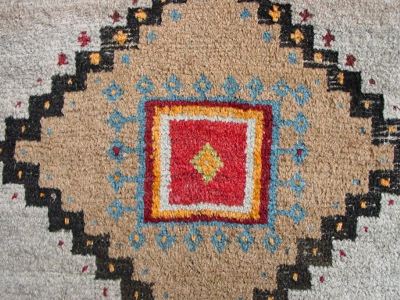
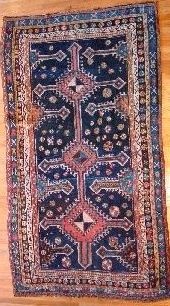
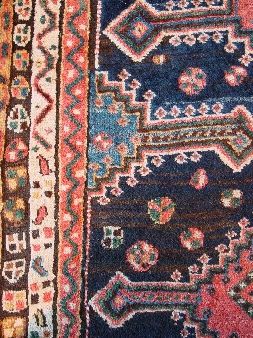
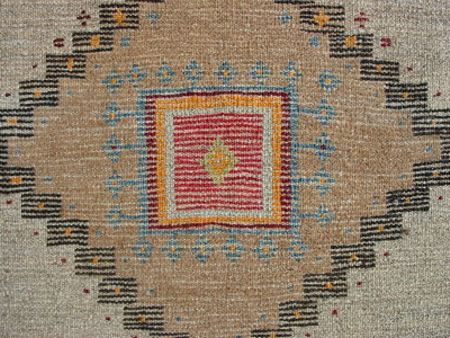
Can anything be gleaned from
the unusual knotting? From the back, the knots seem to go every-which way, not
the typical straight rows, with diagonal jumps and X shapes.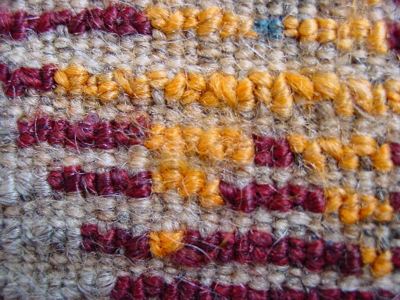
Here is a close up of a rather
tall orange knot collar, almost as though it was wrapped three
times: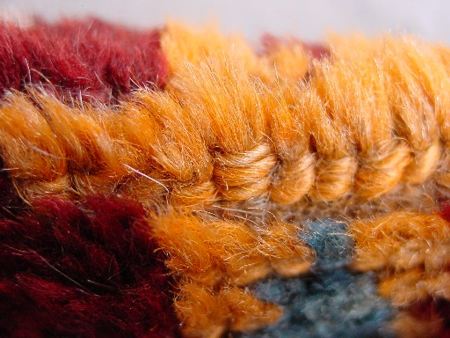
Most
gabbehs have been labelled Qashqa'i, Bakhtiyari or Luri. Usually those with
darker coloration, dark warps and simpler fields have been labelled Luri.
As
for this one, I have never seen one just like it, or close enough to be
certain.
Patrick Weiler
Lori Gabbehs
Tracy,
The Lurs of Fars apparently were preeminent weavers of gabbehs,
along with the Qashqa'i. From Oriental Rug Review comes this excerpt from John
Wertime's article, The Weavings of the Lors and Bakhtiyaris: A Fifteen Year
Retrospective.
http://www.rugreview.com/122c.htm
"...Opie's work plus
my own observation of the market and reading of the literature on Oriental rugs
lead me to believe that the nomadic Bakhtiyati tribes produced few pile rugs.
Unlike those of the Lors, most of the pile rugs that carry a Bakhtiyari label
seem to have been considerably influenced by sedentary peoples and tastes. One
wonders if the extremely rugged terrain traversed by the Bakhtiyaris on their
trek between summer and winter quarters was not a deterrent to the weaving of
heavy pile rugs, as well as to the use of camels.
While the Lors of Fars
are well known for their gabbehs, only recently have the Bakhtiyaris been
identified as weavers of such rugs."
The article does not show any Lori
gabbehs. There are a couple of publications, including the well known "Gabbeh:
The Georges D. Bornet Collection" that show a number of them. This gabbeh,
however, is not quite like those that I have seen in these
publications.
Patrick Weiler